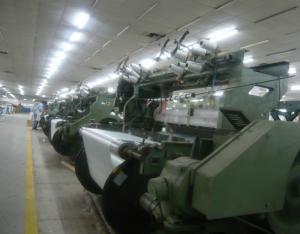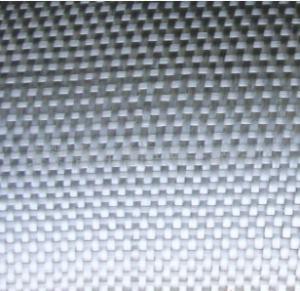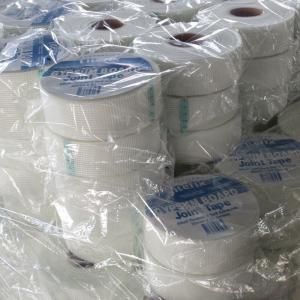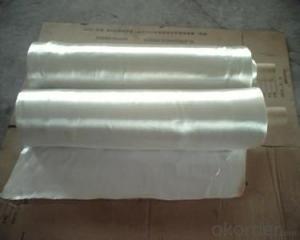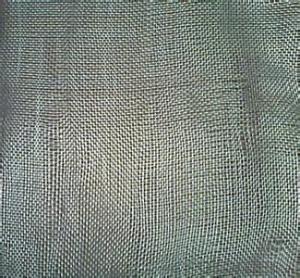Classic Fiberglass Fabrics
- Loading Port:
- Qingdao Port
- Payment Terms:
- TT or LC
- Min Order Qty:
- 10000 M2 m²
- Supply Capability:
- 50000000 M2 Per Year m²/month
OKorder Service Pledge
OKorder Financial Service
You Might Also Like
Introducton of Fiberglass Fabrics for surfboard:
Fiberglass fabric is corrosion resistance, high intensity, electricity insulation, compatibility with other resin. Fiberglass fabric is widely used into electric insulation field for PCB or copper clad laminate.
Technical Data Sheet of Fiberglass Fabrics for surfboard:
Fabric Count Warp×Fill(Per cm) | Yarn(SI)
| Thickness(mm) (Rreference Only) | Nominal Weight(g/m2) | Weight Tolerance(g/m2) |
23.6×18.5 | 5 11 1×0 5 11 1×0 | 0.053 | 46.8 | 45.1-48.5 |
23.6×23.6 | 5 11 1×0 5 11 1×0 | 0.056 | 52.9 | 51.5-54.2 |
19.3×16.5 | 7 45* 1×0 7 45* 1×0 | 0.149 | 164.1 | 157.7-170.5 |
18.1×17.7 | 7 45* 1×0 7 45* 1×0 | 0.140 | 1654.0 | 158.0-171.0 |
23.6×19.7 | 6 33 1×0 6 33 1×0 | 0.125 | 148.0 | 142.8-153.2 |
20.0×10.8 | 9 331×0 9 74 1×0 | 0.135 | 146.2 | 142.1-150.3 |
20.5×20.5 | 9 34* 1×0 9 34* 1×0 | 0.114 | 138.3 | 133.6-143. |
23.6×22.0 | 7 22 1×0 5 11 1×0 | 0.079 | 78.0 | 75.6-80.4 |
22.0×18.9 | 7 22 1×0 7 22 1×0 | 0.084 | 90.9 | 88.5-93.2 |
23.6×22.8 | 7 22 1×0 7 22 1×0 | 0.094 | 103.8 | 100.7-106.8 |
26.0×21.7 | 7 22 1×0 7 22 1×0 | 0.095 | 108 | 104.8-111.2 |
17.3×12.2 | 9 681×0 9 68 1×0 | 0.173 | 203.4 | 198.0-208.9 |
17.9×13.4 | 9 68 1×0 9 68 1×0 | 0.18 | 210.0 | 204.5-215.3 |
17.3×11.4 | 9 68 1×0 9 102* 1×0 | 0.201 | 232.3 | 226.5-238.0 |
17.5×7.9 | 9 68 1×0 9 136* 1×0 | 0.254 | 227.8 | 221.1-234.7 |
17.4×10 | 9 68 1×0 9 136* 1×0 | 0.250 | 260.0 | 255.2-265.3 |
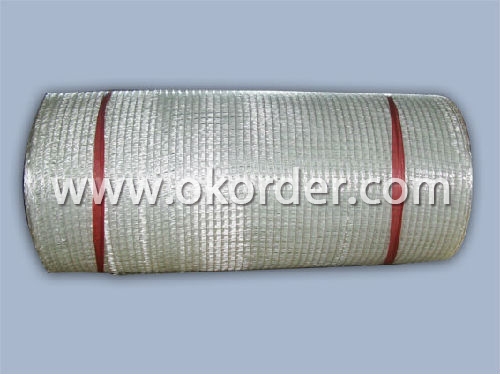
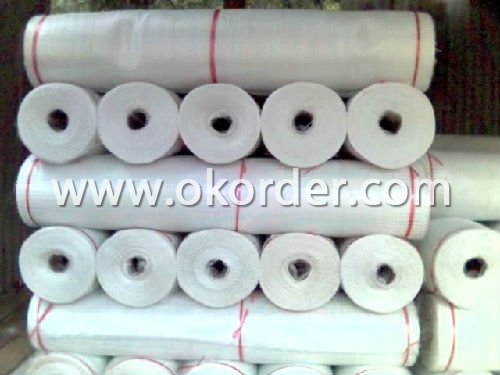
- Q:What is the difference between alkali resistant fiberglass mesh and hot dipped galvanized steel wire mesh?
- Alkali resistant fiberglass mesh cloth softer can only play the deformation of dispersing stress (deformation temperature, deformation and outside) to plaster layer sharing under tension. When the glass fiber cloth mass per unit area increases, the tensile bond strength of tile is bigger, but the increase is not obvious. When the glass fiber cloth mesh size increases, the tensile bond strength of brick decreased after increasing.
- Q:Is fiberglass fabric flame resistant?
- Yes, fiberglass fabric is flame resistant. It is made from glass fibers that have been woven into a fabric. The glass fibers have a high melting point, which makes the fabric highly resistant to catching fire or melting. This makes fiberglass fabric a popular choice in applications where flame resistance is important, such as in insulation, protective clothing, and fireproof curtains. However, it is important to note that while fiberglass fabric is flame resistant, it is not completely fireproof. It may still burn if exposed to high temperatures for prolonged periods of time.
- Q:What is the abrasion resistance of fiberglass fabric?
- The abrasion resistance of fiberglass fabric is quite high. Due to its strong and durable nature, fiberglass fabric is known for its ability to withstand repeated friction and wear without significant damage. It is commonly used in applications where abrasion resistance is crucial, such as in the manufacturing of protective clothing, industrial curtains, and reinforcing materials for composites. The specific abrasion resistance of fiberglass fabric can vary depending on its construction, finish, and any additional coatings or treatments applied to the fabric. However, overall, fiberglass fabric is highly regarded for its excellent resistance to abrasion, making it a popular choice in industries where durability is essential.
- Q:What are the different weights or thicknesses available for fiberglass fabrics?
- There are various weights or thicknesses available for fiberglass fabrics, ranging from lightweight options like 3 oz per square yard to heavier options like 18 oz per square yard.
- Q:What are the different weave styles available for fiberglass fabric?
- There are several different weave styles available for fiberglass fabric, each with its own unique characteristics and applications. Some of the most common weave styles include plain weave, twill weave, satin weave, and leno weave. 1. Plain weave: This is the simplest and most common weave style for fiberglass fabric. It consists of a simple over-under pattern where each warp yarn passes alternately over and under each weft yarn. Plain weave fabrics are typically balanced and have good stability, making them suitable for a wide range of applications. 2. Twill weave: Twill weave is characterized by a diagonal line pattern on the fabric surface. This weave style is created by passing the weft yarn over two or more warp yarns before going under one or more warp yarns. Twill weave fabrics have good strength and durability, making them ideal for applications that require a higher level of performance. 3. Satin weave: Satin weave is known for its smooth and lustrous appearance. It is created by passing the weft yarn over four or more warp yarns before going under one. This weave style produces a high number of floats on the fabric surface, resulting in a silky texture. Satin weave fabrics are lightweight, flexible, and have excellent draping qualities, making them ideal for applications that require a smooth and elegant finish. 4. Leno weave: Leno weave is a unique weave style that creates an open mesh-like structure. It is formed by twisting adjacent warp yarns together and then locking them in place with a weft yarn. Leno weave fabrics are characterized by their high porosity and excellent breathability. They are commonly used in filtration applications and for reinforcing composites. These are just a few examples of the different weave styles available for fiberglass fabric. The choice of weave style depends on the specific requirements of the application, such as strength, weight, flexibility, and aesthetics.
- Q:Are fiberglass fabrics suitable for use in the agricultural industry?
- Indeed, fiberglass fabrics prove to be a fitting choice for implementation within the agricultural sector. The attributes associated with fiberglass fabrics render them optimal for usage in agricultural contexts. Primarily, fiberglass is renowned for its formidable strength and resilience, enabling it to brave the demanding conditions frequently encountered in agricultural environments. Consequently, fiberglass fabrics can be employed for a multitude of purposes, such as covering greenhouses, safeguarding crops against pests and inclement weather, and reinforcing agricultural machinery. Moreover, fiberglass fabrics possess resistance against chemicals and UV radiation, an indispensable quality within the agricultural industry due to the prevalence of fertilizers, pesticides, and exposure to sunlight. The chemical resistance guarantees that the fiberglass fabrics will remain intact and unaffected by these substances. Furthermore, UV resistance prevents the fabric from deteriorating or becoming brittle when exposed to sunlight for prolonged periods. Another noteworthy advantage of fiberglass fabrics in the agricultural realm is their fire resistance. This characteristic plays a crucial role in averting the fire's proliferation in the event of accidents or incidents involving flammable materials frequently found in agricultural settings. Furthermore, fiberglass fabrics are lightweight and effortless to handle, offering convenience for an array of applications within the agricultural sector. They can be effortlessly cut and customized to fit specific requirements, allowing for tailored solutions based on the preferences of farmers and agricultural workers. Ultimately, the combination of strength, durability, chemical resistance, UV resistance, fire resistance, and ease of handling renders fiberglass fabrics exceedingly suitable for implementation within the agricultural industry. They provide a dependable and versatile solution for diverse applications, contributing to the efficiency and productivity of agricultural operations.
- Q:Is fiberglass fabric resistant to UV degradation in outdoor applications?
- Yes, fiberglass fabric is highly resistant to UV degradation in outdoor applications. Fiberglass fabric is made from fibers that are manufactured to withstand prolonged exposure to sunlight and other environmental factors. The fabric is treated with special coatings or finishes that provide additional protection against UV radiation. This UV resistance makes fiberglass fabric an ideal choice for outdoor applications where exposure to sunlight is a concern, such as in awnings, canopies, and outdoor furniture. Additionally, fiberglass fabric maintains its strength and integrity even after years of exposure to UV rays, ensuring its long-lasting performance in outdoor settings.
- Q:How does fiberglass fabric perform in vibration isolation applications?
- Fiberglass fabric is commonly used in vibration isolation applications due to its excellent performance in this regard. The fabric's inherent properties, such as high tensile strength, flexibility, and low thermal conductivity, make it an ideal material for effectively isolating vibrations. When subjected to vibrations, fiberglass fabric absorbs and dampens the energy generated, thereby reducing the transfer of vibrations from one component to another. This ability to absorb vibrations is crucial in various industries, including automotive, aerospace, and construction, where minimizing vibrations is essential for optimal performance and safety. Additionally, fiberglass fabric's high tensile strength ensures that it can withstand the forces and stresses associated with vibrations without tearing or breaking. This strength is important for maintaining the fabric's integrity and effectiveness as a vibration isolator, as any damage to the fabric could compromise its performance. Furthermore, the flexibility of fiberglass fabric allows it to conform to different shapes and surfaces, ensuring a secure and tight fit in vibration isolation applications. This flexibility enables the fabric to effectively isolate vibrations across a wide range of frequencies and amplitudes, making it a versatile solution for various vibration control needs. Lastly, fiberglass fabric's low thermal conductivity is advantageous in vibration isolation applications where temperature differentials exist. By minimizing heat transfer, the fabric helps maintain the stability and performance of the isolated components, especially in environments with extreme temperatures. In summary, fiberglass fabric performs exceptionally well in vibration isolation applications due to its ability to absorb and dampen vibrations, high tensile strength, flexibility, and low thermal conductivity. Its effectiveness, versatility, and durability make it a preferred choice for industries requiring efficient vibration control.
- Q:Can fiberglass fabrics be used in high-temperature environments?
- Yes, fiberglass fabrics can be used in high-temperature environments. Fiberglass is known for its excellent heat resistance properties, making it a suitable choice for applications that require insulation or protection against high temperatures. It can withstand temperatures of up to 1000°F (538°C) without losing its structural integrity or performance. These fabrics are commonly used in industries such as aerospace, automotive, and manufacturing, where high temperatures are present. Additionally, fiberglass fabrics are lightweight, durable, and possess good thermal conductivity, making them an ideal material for high-temperature environments.
- Q:Is fiberglass fabric resistant to chemicals in pharmaceutical industry?
- Yes, fiberglass fabric is generally resistant to chemicals in the pharmaceutical industry. Fiberglass is made from glass fibers that are woven together, creating a strong and durable fabric. This fabric is known for its resistance to many chemicals, including those commonly used in the pharmaceutical industry such as acids, alkalis, solvents, and various cleaning agents. Fiberglass fabric is also non-reactive, meaning it does not readily interact with chemicals or release harmful substances. This makes it a suitable choice for applications where chemical resistance is important, such as in the pharmaceutical industry where the fabric may come into contact with various chemicals during manufacturing processes or in cleanrooms. However, it is important to note that the specific type of fiberglass fabric and the specific chemicals involved should be considered to ensure proper compatibility and resistance.
1. Manufacturer Overview |
|
|---|---|
| Location | Shandong, China |
| Year Established | 1964 |
| Annual Output Value | Above US$ 20 Million |
| Main Markets | 20.00% North America 20.00% South America 10.00% Eastern Europe 10.00% Southeast Asia 10.00% Northern Europe 10.00% South Asia 10.00% Western Europe 5.00% Africa 5.00% Mid East |
| Company Certifications | ISO9001:2000 |
2. Manufacturer Certificates |
|
|---|---|
| a) Certification Name | |
| Range | |
| Reference | |
| Validity Period | |
3. Manufacturer Capability |
|
|---|---|
| a)Trade Capacity | |
| Nearest Port | Qingdao Port |
| Export Percentage | 31% - 40% |
| No.of Employees in Trade Department | 10-20 People |
| Language Spoken: | English; Chinese; |
| b)Factory Information | |
| Factory Size: | Above 200,000 square meters |
| No. of Production Lines | Above 10 |
| Contract Manufacturing | Design Service Offered; Buyer Label Offered |
| Product Price Range | High; Average |
Send your message to us
Classic Fiberglass Fabrics
- Loading Port:
- Qingdao Port
- Payment Terms:
- TT or LC
- Min Order Qty:
- 10000 M2 m²
- Supply Capability:
- 50000000 M2 Per Year m²/month
OKorder Service Pledge
OKorder Financial Service
Similar products
New products
Hot products
Hot Searches
Related keywords
